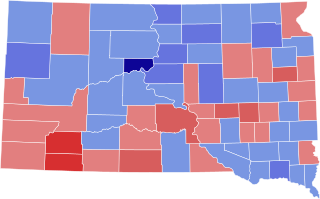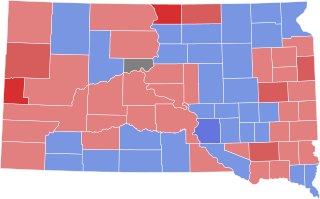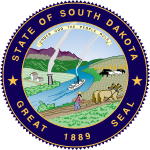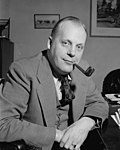
Karl Earl Mundt was an American educator and a Republican member of the United States Congress, representing South Dakota in the United States House of Representatives (1939–48) and in the United States Senate (1948–73).

Harlan John Bushfield was an American politician from South Dakota. He served as the 16th governor of South Dakota and as a United States senator.

Vera Sarah Bushfield was an American politician served as a U.S. senator from South Dakota in 1948, as well as the First Lady of South Dakota from 1939 to 1943. Bushfield's appointment also marked the first time one state had been represented by two female senators; Gladys Pyle served for two months in late 1938 and early 1939.

The 1932 United States Senate election in South Dakota took place on November 8, 1932. Incumbent Republican Senator Peter Norbeck ran for re-election to a third term. After easily turning back a challenge from former State Senator Harry F. Brownell in the Republican primary, Norbeck faced attorney Ulysses Simpson Grant Cherry, the Democratic nominee, in the general election. Owing in part to Franklin D. Roosevelt's landslide victory in South Dakota, the race was much closer than it was in 1926, but Norbeck still defeated Cherry by a decisive margin to win his third, and final, term. Norbeck died in office on December 20, 1936, triggering a special election in 1938.

The 1904 South Dakota gubernatorial election was held on November 8, 1904. Incumbent Republican Governor Charles N. Herreid declined to run for re-election to a third term. Clark County State's Attorney Samuel H. Elrod won the Republican nomination to run as Herreid's successor, and he faced Democratic nominee Louis N. Crill, the former President of the State Senate, and former U.S. Congressman Freeman Knowles, the Socialist nominee. For the first time since 1894, the Democratic and Populist Parties nominated separate candidates. Ultimately, the split in the two parties did not prove dispositive; Elrod defeated Crill and the other candidates in a landslide.

The 1920 United States Senate election in South Dakota took place on November 2, 1920. Incumbent Democratic Senator Edwin S. Johnson declined to seek re-election to a second term. In the Democratic primary, attorney Ulysses Simpson Grant Cherry defeated former State Senator Louis Napoleon Crill and former U.S. Marshal Tom Taubman, while in the Republican primary, Governor Peter Norbeck defeated former State Supreme Court Justice Dick Haney. In the general election, Cherry and Norbeck faced a litany of independent candidates, including Nonpartisan League candidate Tom Ayres. Benefiting from the split in left-wing candidates, Norbeck won by a wide margin, with Ayres narrowly beating out Cherry for second place.

The 1942 United States Senate election in South Dakota took place on November 3, 1942. Incumbent Democratic Senator William J. Bulow ran for re-election to a third term. During the primary, Bulow was attacked for being insufficiently supportive of President Franklin Roosevelt's foreign policy and war preparedness. Former Governor Tom Berry, Bulow's chief opponent, drew a contrast between Bulow's isolationism and his support for Roosevelt's policies. In the end, Berry defeated Bulow in a landslide, and advanced to the general election, where he faced Harlan J. Bushfield, the incumbent Republican Governor of South Dakota. As Republicans gained ground nationwide, Bushfield defeated Berry in a landslide to pick up the seat for the Republican Party. Bushfield did not serve his full term, however; shortly before the 1948 U.S. Senate election, he died.

The 1950 United States Senate election in South Dakota took place on November 7, 1950. Incumbent Republican senator Chan Gurney ran for re-election to a third term. He was challenged in the Republican primary by Congressman Francis H. Case, who had represented the 2nd District since 1939. In the general election, Case faced John A. Engel, an attorney and the 1948 Democratic nominee for the U.S. Senate. As the Republican Party was making significant gains nationwide, Case defeated Engel in a landslide.

The 1918 United States Senate election in South Dakota took place on November 5, 1918. Incumbent Republican Senator Thomas Sterling sought re-election in his first popular election. He defeated former Governor Frank M. Byrne in the Republican primary and then faced former State Representative Orville Rinehart, the 1916 Democratic nominee for Governor, in the general election. Sterling defeated Rinehart, along with independent candidate W. T. Rafferty, by a wide margin to win re-election.

The 1930 United States Senate election in South Dakota took place on November 4, 1930. Incumbent Republican Senator William H. McMaster ran for re-election to a second term. After beating back a challenge in the Republican primary from former State Senator George J. Danforth, McMaster faced Democratic nominee William J. Bulow, the incumbent Governor, in the general election. As the Democratic Party performed well nationwide, Bulow narrowly defeated McMaster.

The 1954 United States Senate election in South Dakota took place on November 2, 1954. Incumbent Republican Senator Karl E. Mundt ran for re-election to his second term. He was opposed by former State Representative Kenneth Holum, the Democratic nominee. Mundt defeated Holum in a landslide to win re-election.

The 1960 United States Senate election in South Dakota took place on November 8, 1960. Incumbent Republican Senator Karl E. Mundt ran for re-election to his third term. He was challenged by Congressman George McGovern. Both Mundt and McGovern won their respective primaries unopposed and the campaign between the two began. Despite the landslide victory for Vice-President Richard M. Nixon over John F. Kennedy, the race between Mundt and McGovern was quite close. Mundt narrowly won re-election, and McGovern ran for the U.S. Senate again in 1962. He served alongside Mundt for a decade.

The 1962 United States Senate election in South Dakota took place on November 6, 1962. Incumbent Republican Senator Francis H. Case ran for re-election to a third term. He won the Republican primary against Attorney General A. C. Miller, but shortly after the primary, died. The Republican State Central Committee named Lieutenant Governor Joseph H. Bottum as Case's replacement on the ballot, and Governor Archie Gubbrud appointed Bottum to fill the vacancy caused by Case's death. In the general election, Bottum was opposed by Democratic nominee George McGovern, the Director of Food for Peace and the former U.S. Congressman from South Dakota's 1st congressional district. The contest between Bottum and McGovern was quite close, with McGovern narrowly defeating him for re-election by just 597 votes, making him the first Democrat to win a Senate election in South Dakota since William J. Bulow's win in 1936.

The 1966 United States Senate election in South Dakota took place on November 8, 1966. Incumbent Republican Senator Karl E. Mundt ran for re-election to his fourth term. He was challenged in the Republican primary by a John Birch Society member, but easily turned away the challenge. In the general election, he faced State Representative Donn Wright, the Democratic nominee. Owing in large part to the Republican landslide taking place nationwide, Mundt defeated Wright by an unprecedented margin.

The 1968 United States Senate election in South Dakota took place on November 5, 1968. Incumbent Democratic Senator George McGovern ran for re-election to a second term. He was challenged by former Governor Archie M. Gubbrud, who was persuaded to enter the race by the South Dakota Republican establishment. McGovern defeated Gubbrud by a wide margin, even as Richard Nixon was defeating Hubert Humphrey in the state's presidential election in a landslide.

The 1938 United States Senate elections in South Dakota took place on November 8, 1938. Incumbent Republican Senator Peter Norbeck died in office on December 20, 1936. Herbert E. Hitchcock was appointed by Governor Tom Berry as Norbeck's replacement. Two elections for the same Senate seat were held on the same day; one as a special election to fill the remainder of Norbeck's six-year term, and another to select a Senator to serve the next six-year term.

The 1930 South Dakota gubernatorial election was held on November 4, 1930. Incumbent Democratic Governor William J. Bulow declined to run for re-election to a third term, instead opting to successfully run for the U.S. Senate. The Republican nomination was hard-fought and the primary was crowded; because no candidate received 35% of the vote, state law required that the nomination be decided at a state party convention. There, former State Senator Warren Green, the last-place finisher in the primary, defeated Secretary of State Gladys Pyle, the plurality winner. In the general election, Green faced D. A. McCullough, the state's Rural Credits Commissioner and the Democratic nominee. Despite Bulow's success in the preceding two elections, Green defeated McCullough by a decisive margin—even as Bulow himself was elected to the U.S. Senate.

The 1938 South Dakota gubernatorial election was held on November 8, 1938. Incumbent Republican Governor Leslie Jensen declined to seek re-election and instead unsuccessfully ran for the U.S. Senate. Harlan J. Bushfield, the former Chairman of the South Dakota Republican Party, won the Republican primary to succeed Jensen. In the general election, he faced Democratic nominee Oscar Fosheim, a State Representative from Miner County, in the general election. Bushfield defeated Fosheim by a relatively close margin, winning his first term as governor.

The 1940 South Dakota gubernatorial election was held on November 5, 1940. Incumbent Republican Governor Harlan J. Bushfield sought re-election to a second term. After winning the Republican primary by a large margin, he faced Democrat Lewis W. Bicknell, former Day County State's Attorney, in the general election. Though Bushfield underperformed Republican presidential nominee Wendell Willkie, who won the state in a landslide, he nonetheless defeated Bicknell by a wide margin to easily win re-election.

The 1942 South Dakota gubernatorial election was held on November 3, 1942. Incumbent Republican Governor Harlan J. Bushfield declined to seek re-election to a third term and instead successfully ran for the U.S. Senate. A crowded Republican primary developed to succeed him, and because no candidate received 35% of the vote, the nomination was decided at the state Republican convention, where former Attorney General Merrell Q. Sharpe, the second-place finisher in the primary, won the nomination. In the general election, Sharpe faced Democratic nominee Lewis W. Bicknell, the 1940 Democratic nominee for Governor. Aided by the national Republican landslide, Sharpe defeated Bicknell in a landslide.

















